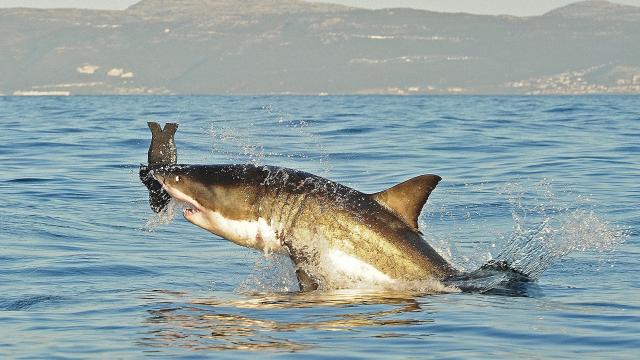Sharks are doing really badly, according to a new report. The study, put together by the Global Shark Trends Project and published in Nature on Wednesday, found that the number of sharks and rays in the world’s oceans has fallen by more than 70% since 1970.
The main reason for this rapid decline, the authors write, is overfishing. Over that period of loss, the findings show there’s been an 18-fold increase in “relative fishing pressure,” which is a measure of the proportion of sharks and rays caught by fishers relative to their global population. It’s a jarring example of the extinction crisis unfolding across the planet, and could have vast repercussions for ecosystems around the world if we don’t change course.
The authors, who come from all over the world and have been working on the report together for 10 years, obtained data on the most common, wide-ranging species of oceanic sharks and rays, all of which inhabit the open water beyond the continental shelf. They set out to determine how those species were doing based on two indicators established by the United Nations’ Convention on Biological Diversity. The first, the Living Planet Index, tracks species’ global population changes since 1970, and the second, the Red List Index, tracks species’ extinction risk based on their population health and the threats they face in the wild. These in turn relate to international targets and goals that tie to human well-being as well.
“These indicators quantify progress toward the UN Sustainable Development and Biodiversity goals,” Nathan Pacoureau, the study’s lead author and a biology researcher at Simon Fraser University in British Columbia, said in an email.
The authors identified the world’s 31 most wide-ranging sharks and rays for the study. But even after a deep dive into past scientific literature and government reports, they were only able to conduct their Living Planet Index analysis on 18 of them since sufficient historical population data was not kept on the others.
After compiling 57 time-stamped datasets on the 18 species and having them reviewed by experts with the United Nations International Union for Conservation of Nature, the authors modelled how abundant each of the species was in each of the past 50 years. On average, the study found that the species had declined by a whopping 71% since 1970, at a “steady rate averaging 18.2% per decade.”
Based on a model created by the Sea Around Us project at the at the University of British Columbia, the authors used data on species population decline over time and fishing patterns to determine that fishing is the main reason the animals are under threat.
“In the past 50 years, human populations and fishing activity have doubled while our shark catch has tripled,” Pacoureau said. “Combined with their increasing rarity, that means relative fishing pressure on sharks and rays is now 18 times greater.”
The authors took a look at the current state of the 31 species they originally wanted to study using the International Union for Conservation of Nature’s Red List, which is the world’s most comprehensive inventory of the risks facing plant and animal species. The system assesses how threatened species are based on their rate of population decline and geographic range.
“The data revealed a gaping, growing hole in ocean life,” said Pacoureau.
Indeed, what they found was bleak: Under the Red List’s criteria, three-quarters of the species they examined qualify as “threatened with extinction.”
Sharks are sought out for their meat and liver oil. Elasmobranchii — or a type of cartilaginous fish species — like them are particularly vulnerable to overfishing because they birth so few young. Plus, they’re not very well protected. Sharks have been passed over for more rigorous protections, even as things like “ghost fishing gear” left behind by commercial operations poses an ever-greater threat to them.
“The regional bodies that manage international fisheries for oceanic fish have poor records for heeding scientific advice and have not prioritised shark and ray protection,” Pacoureau.
The loss of these species is particularly troubling because many of them are apex predators that sit at the top of their marine food chains, meaning they have a major influence on the structure of ecosystems. To protect them, the researchers urge governments to immediately implement stricter regulations on fishing for them in the world’s oceans. Specifically, the authors argue that leaders should instate strict catch limits and even bans on catching the most threatened species, and measures to regulate the use of fishing gear so that sharks aren’t accidentally killed in the process of hunting for other marine life.
When they’re levied, there’s evidence that these policies work. The study notes white sharks saw a 70% decline over the past 50 years, but bans in some regions are helping populations recover.
The researchers are also calling on the world’s scientists and governments to pay more attention to sharks. Pacoureau said the UN measures on species’ well-being are most often used to analyse terrestrial creatures. Those in the depths of the ocean are often neglected, but the study indicates that in fact, elasmobranchii may be some of the most threatened animals on Earth.
“Where once this data was dominated by mammals, birds, and amphibians, for the first time we can show the alarming consequences of overfishing in the ocean through the dramatic declines of some of its most iconic inhabitants,” Pacoureau said. “That’s a big scientific step forward for human and ocean-kind — one that our policymakers should no longer ignore.”
